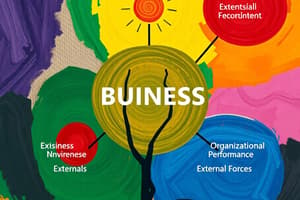Podcast
Questions and Answers
What does environmental uncertainty primarily involve?
What does environmental uncertainty primarily involve?
- The complexity of environmental components
- The frequency of organizational changes
- The degree of change and complexity of the environment (correct)
- The organizational structure and policies
Which factor does NOT belong to the general environment of an organization?
Which factor does NOT belong to the general environment of an organization?
- Socio-cultural values
- Technological advancements
- Competitors (correct)
- Economic growth
Which of the following best defines the competitive environment?
Which of the following best defines the competitive environment?
- The external factors affecting all organizations in the market
- Political stability influencing organizational strategy
- Technological innovations affecting production methods
- The specific industry-related forces such as suppliers and customers (correct)
Which economic factor is NOT typically considered in the general environment?
Which economic factor is NOT typically considered in the general environment?
What does the socio-cultural factor encompass in the general environment?
What does the socio-cultural factor encompass in the general environment?
Which aspect does the international PESTEL analysis NOT cover?
Which aspect does the international PESTEL analysis NOT cover?
How do technological factors impact the business environment?
How do technological factors impact the business environment?
Which of the following demographic characteristics does NOT directly affect the business environment?
Which of the following demographic characteristics does NOT directly affect the business environment?
How does the number of competitors affect the level of industry profits?
How does the number of competitors affect the level of industry profits?
What factor increases the bargaining power of suppliers?
What factor increases the bargaining power of suppliers?
Which of the following is NOT a characteristic of a strong organizational culture?
Which of the following is NOT a characteristic of a strong organizational culture?
What is a primary outcome of high rivalry among competitors according to Porter’s model?
What is a primary outcome of high rivalry among competitors according to Porter’s model?
Which dimension of organizational culture emphasizes innovation and flexibility?
Which dimension of organizational culture emphasizes innovation and flexibility?
Which stakeholders are considered internal stakeholders of a company?
Which stakeholders are considered internal stakeholders of a company?
What effect does a strong organizational culture have on employee behavior?
What effect does a strong organizational culture have on employee behavior?
Which of the following best describes the 'threat of substitutes' in an industry?
Which of the following best describes the 'threat of substitutes' in an industry?
What is the primary challenge posed by barriers to entry in a market?
What is the primary challenge posed by barriers to entry in a market?
In which dimension of organizational culture does management prioritize results over processes?
In which dimension of organizational culture does management prioritize results over processes?
What aspect significantly impacts the establishment of an organization’s culture?
What aspect significantly impacts the establishment of an organization’s culture?
What is the role of distributors in a competitive environment?
What is the role of distributors in a competitive environment?
Which factor does NOT influence the intensity of rivalry among competitors?
Which factor does NOT influence the intensity of rivalry among competitors?
What is an expected outcome for shareholders of a company?
What is an expected outcome for shareholders of a company?
Flashcards
Business Environment
Business Environment
Forces outside an organization that affect its performance.
Environmental Uncertainty
Environmental Uncertainty
The degree to which factors in the business environment are uncertain or unpredictable.
General Environment
General Environment
The general set of political, economic, socio-cultural, technological, environmental, and legal conditions that affect all businesses.
Competitive Environment
Competitive Environment
Signup and view all the flashcards
Political and Legal Environment
Political and Legal Environment
Signup and view all the flashcards
Socio-cultural Environment
Socio-cultural Environment
Signup and view all the flashcards
Technological Environment
Technological Environment
Signup and view all the flashcards
PESTEL Analysis
PESTEL Analysis
Signup and view all the flashcards
Porter's Five Forces Model
Porter's Five Forces Model
Signup and view all the flashcards
Rivalry Among Competitors
Rivalry Among Competitors
Signup and view all the flashcards
Barriers to Entry
Barriers to Entry
Signup and view all the flashcards
Bargaining Power of Suppliers
Bargaining Power of Suppliers
Signup and view all the flashcards
Bargaining Power of Buyers
Bargaining Power of Buyers
Signup and view all the flashcards
Threat of Substitutes
Threat of Substitutes
Signup and view all the flashcards
Organizational Culture
Organizational Culture
Signup and view all the flashcards
Strong Culture
Strong Culture
Signup and view all the flashcards
Weak Culture
Weak Culture
Signup and view all the flashcards
Visible Artefacts
Visible Artefacts
Signup and view all the flashcards
Invisible Aspects of Culture
Invisible Aspects of Culture
Signup and view all the flashcards
Stakeholders
Stakeholders
Signup and view all the flashcards
External Stakeholders
External Stakeholders
Signup and view all the flashcards
Internal Stakeholders
Internal Stakeholders
Signup and view all the flashcards
Study Notes
Business Environment
- Environment encompasses external institutions affecting organizational performance.
- Environmental uncertainty varies based on change and complexity.
- Change reflects frequency of component shifts.
- Complexity depends on environment components and organizational knowledge.
General Environment
- General environment comprises broad factors affecting all organizations.
- Political, economic, socio-cultural, technological, environmental, and legal facets are included.
Major Forces in the General Environment
- Economic: Interest rates, inflation, unemployment, economic growth.
- Technological: Infrastructure, technological advancements, industrial innovations, production/distribution changes.
- Political and Legal: Political stability, government regulations, changes in laws/regulations.
- Socio-cultural: Customs, values, traditions, lifestyles, beliefs, behavior patterns.
- Demographic: Population characteristics (age, gender, ethnicity, race, sexual orientation, social class).
- Environmental: Production methods affecting the environment, sustainable energy consumption, climate change.
- International: Organizational involvement and effects from international business.
International PESTEL Analysis
- Political: Government attitudes to investment, political stability, patent/intellectual property policies.
- Economic: Growth rates, wealth distribution, currency stability, exchange rates.
- Socio-cultural: National cultures, attitudes toward foreign companies/staff.
- Technological: Telecommunications, infrastructure, power supply, import/export transport.
- Environmental: Natural resources, quality, climate change effects.
- Legal: Tariffs, trade agreements, employment protection, company taxation.
Competitive Environment
- Competitive forces stem from customers, suppliers, distributors, and competitors.
- Impact business capability for input acquisition and output disposal.
Porter's Five Forces Model
- Analyzes industry attractiveness.
- Rivalry among competitors: Higher rivalry = lower attractiveness and profits.
- Number of competitors, growth in demand, product differentiation, barriers to exit impact rivalry.
- Threat of new entrants: Lower barriers = lower industry profits.
- Barriers to entry (capital, economies of scale, licenses, customer loyalty) affect new entrants.
- Bargaining power of suppliers: Higher supplier power = lower profits.
- Supplier number, customer purchasing patterns, supplier expansion potential, switch costs influence supplier power.
- Bargaining power of buyers: Higher buyer power = lower profits.
- Threat of substitutes: Alternative products/services in other industries.
- Rivalry among competitors: Higher rivalry = lower attractiveness and profits.
Organizational Culture
- Internal environment encompassing people, culture, structure and technology.
- Organizational culture: Shared values, principles, traditions and practices shaping organizational behavior.
- Strong culture: Behaviors strongly linked to widely shared values. Employees identify and share company stories.
- Weak culture: Values limited to top management. Employees don't strongly identify; messages are inconsistent.
Levels of Organizational Culture
- Visible artefacts: Observable aspects (dress, behavior, symbols, ceremonies, layout).
- Invisible: Underlying aspects (values/beliefs, assumptions, role modeling, legends, language).
Dimensions of Organizational Culture
- Adaptability
- Attention to detail
- Outcome orientation
- People orientation
- Team orientation
- Integrity
How is Culture Established?
- Founders' vision is the initial source.
- Transmission through stories, material symbols, and language.
- Organizational practices maintain culture (selection & socialization processes).
- Top management actions greatly influence the culture.
Stakeholders
- Stakeholders: Individuals/groups with interests in the company.
Stakeholders and the Company
- External: Customers, suppliers, creditors, governments, unions, local communities, general public.
- Internal: Stockholders, employees, managers, senior executives, board members.
Stakeholder Claims
- Stockholders: Maximize return on investment (owners).
- Managers: Decide on best stakeholder benefits, resource efficiency.
- Employees: Seek rewards for contributions.
- Suppliers: Fair, prompt payment expected.
- Distributors: Quality products at agreed prices.
- Customers: Attracting customers and business continuance.
- Community: Infrastructure for company operations.
Studying That Suits You
Use AI to generate personalized quizzes and flashcards to suit your learning preferences.




